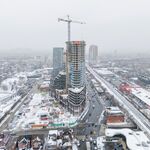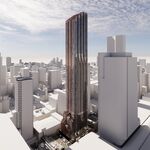When St Claire was given it's own right of way the line actually got slower. When the Spadina bus got upgraded to "LRT," the line got slower. When the Flexities arrived in Toronto, the city reduced headways (because they had higher capacity) and
slowed down the trains further. So now lines like Spadina and St Claire are both slower AND less frequent with the streetcars in their own line. Giving a streetcar its own lane isn't a magical speed boost. It improves reliability, sure (and I believe all the streetcar routes should have their own lanes). But things like operational procedures and stop spacing will affect actual service. Thankfully the contract signed for Finch LRT is for 5 minutes at peak, which is about the same as the 36A Bus currently. (Not counting the branches)
I agree that stations should be close enough together that it doesn't leave huge areas unserved in between. Being an LRT whose main purpose is to be a higher capacity bus, 500m is reasonable. But being closer to 800-700 is better If it is a subway. (and probably 1km spacing if it is meant to connect distant parts of the city together at a reasonable speed)
Nobody* complains that walking to locations in the central section of Line 2 is hard. The distance between Jane Station and Broadview (10.7km) is just slightly more than the same distance as between Finch West to Humber College (10.3km). Line 2 has 17 stations in that distance. Fench W has 18. Currently, the subway takes only 25min to cover that distance. Finch W is expected to take 36min. That is not just station spacing at play. The fact that the subway can go as fast as possible between stations without worrying about left-turning traffic or pedestrians is huge.
*other than the ones that want an express cross-town route who want to go from end to end.
I have walked the Finch W LRT route from end to end to check on the project. There is enough space to have built it as an elevated line. Cute tiny trains (like REM East or Canada Line) would have been enough to cover the capacity needed for this route. But it is true that it probably would have doubled the cost and also true that it wouldn't look like some cute euro tram urban fantasy that the city likes right now.




